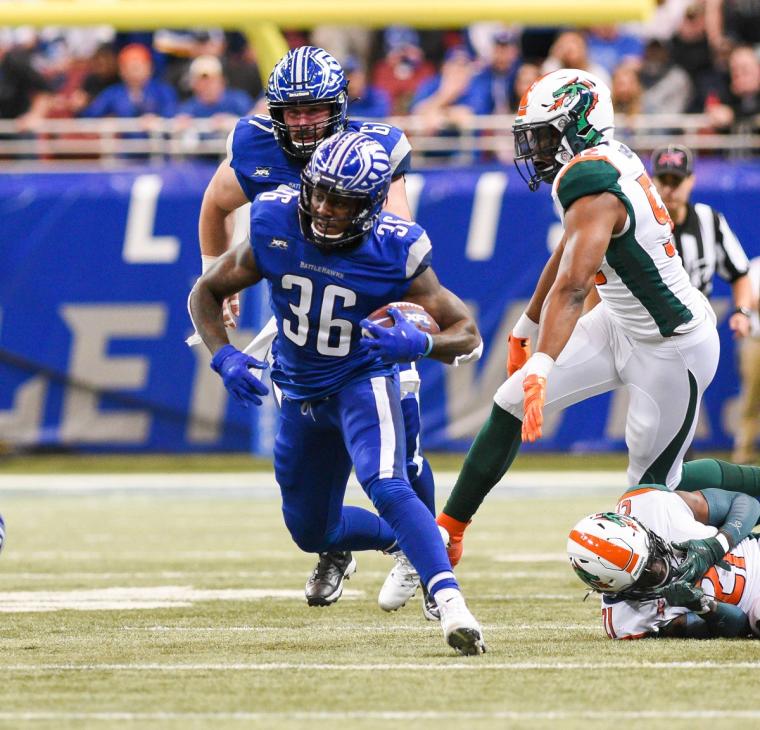
An average of 1.43 million people watched the championship game of XFL 3.0 on May 13, and nearly 23,000 fans attended the game, in which the Arlington Renegades beat the D.C. Defenders, 35-26, at San Antonio’s Alamodome. And both XFL and ESPN executives seem pleased.
“It performed within our expectations,” Tim Reed, ESPN’s vice president of programming and acquisitions, told TheAthletic.com. “We ended on a high note.”
“Knowing that we have a lot of work to do, I just see a tremendous amount of success,” Dany Garcia, who purchased the eight-team XFL for $15 million with actor, business partner and ex-husband Dwayne “The Rock” Johnson in 2020, told USA Today.
“Rome wasn’t built in a day. This league isn’t going to be built in a day. It’s day by day, year over year,” added Johnson, who played football in college. “I felt like we showed a lot of promise in a lot of areas, and we’ve got a lot of great work ahead of us.”
The paper reports that “overall, the league averaged roughly 13,000 fans and 561,000 television viewers per regular-season game, according to game-by-game figures compiled by the website XFL News Hub.”
“Renewals are going out now for ‘24 season tickets, and we still have data coming in from this season,” Janet Duch, the XFL’s chief marketing and team business operations officer, told Front Office Sports. “What is the engagement? Where is the growth? For us right now, we are taking all the learnings from ’23 and applying them to ’24.”
Meanwhile, the second iteration of the United States Football League is more than midway through its 10-game second season, with the playoffs slated for June 24-25 and the championship game set for July 1. NBC and FOX will broadcast the games. Unlike the NFL, which played all of its games in each team’s market, USFL games are played in four hub cities: Birmingham, Alabama; Detroit, Michigan; Memphis, Tennessee; and Canton, Ohio.
Last year’s USFL championship game on FOX averaged 1.52 million, with the number of regular-season viewers averaging 715,000, according to TheAthletic.com. By comparison, the NFL remains untouchable, averaging 16.7 million viewers per regular-season game during the 2022-23 season on multiple networks.
That said, the XFL and USFL collectively represent “a milestone few football leagues without those three red letters on a shield have reached over the last two-plus decades,” notes Front Office Sports, which goes on to list the failures of four stalled attempts by other non-NFL leagues. They include:

• The All American Football League, which “failed to reach kickoff before ending in 2010.”
• The United Football League, which folded in 2012 after three-plus seasons.
• The Stars Football League, which lasted from 2011-13.
• The Alliance of American Football, which “halted operations two weeks before the playoffs in its first and only season in 2019.”
And the XFL is already talking expansion, although most likely not before 2025.
“When you think about it, we’ve just got to continue to do the diligence and put in the work and look at these markets,” Johnson told USA Today. “I think every market has shown promise, and I think we just continue to work and see how it all shakes out.”
The Sporting News recently ran a review of both leagues and found many similarities, including the quality of play.
“The USFL has the XFL edged ever-so-slightly in the battle for spring league superiority,” concluded Jacob Camenker. “Why? It’s all about the broadcast. That is the way that most football fans consume the sport, so given the USFL’s innovative angles and the presence of [acclaimed analyst Joel] Klatt among its on-air talent, that is the prime differentiating factor between the two leagues. That isn’t a slight to the XFL by any means. They certainly have the star power … needed to thrive in the spring football space. And, in fact, there are plenty of pros for both the XFL and USFL that suggest that one — or both — of the spring leagues can survive long-term.”

